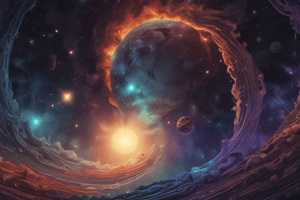Podcast
Questions and Answers
What marks the transformation of a protostar into a main-sequence star?
What marks the transformation of a protostar into a main-sequence star?
- Formation of an accretion disk
- Collapse under gravity
- Initiation of nuclear fusion (correct)
- Explosion into a supernova
All stars last the same amount of time on the main sequence.
All stars last the same amount of time on the main sequence.
False (B)
What occurs when the hydrogen in a star's core is depleted?
What occurs when the hydrogen in a star's core is depleted?
The star leaves the main sequence.
A core with a mass exceeding 3 times that of the Sun will collapse into a __________.
A core with a mass exceeding 3 times that of the Sun will collapse into a __________.
Match the outcomes of a star's core collapse with their conditions:
Match the outcomes of a star's core collapse with their conditions:
Flashcards
Star formation
Star formation
Stars are born from collapsing clouds of gas and dust called nebulae.
Main Sequence Star
Main Sequence Star
A star that fuses hydrogen in its core, being a stable phase.
Supernova
Supernova
Powerful explosion marking a massive star's demise.
Neutron Star
Neutron Star
Signup and view all the flashcards
Black Hole
Black Hole
Signup and view all the flashcards
Study Notes
Star Formation and Evolution
- Stars form in nebulae, vast clouds of gas and dust.
- Gravity causes these clouds to collapse, creating a protostar.
- Nuclear fusion ignites in the protostar's core, transforming it into a main sequence star.
Main Sequence Star Lifespan
- Star lifespan depends on mass; larger stars burn faster.
- Hydrogen fuel eventually depletes, causing the star to leave the main sequence.
Massive Star Evolution
- Massive stars fuse successively heavier elements (like helium, carbon, and oxygen).
- Fusion progresses to iron, where energy production stops.
- Core collapse triggers a supernova explosion.
Stellar Remnants
- Neutron Star: A core between 1.4 and 3 times the Sun's mass collapses into a neutron star.
- Black Hole: A core exceeding this mass collapses into a black hole, an incredibly dense region with immense gravitational pull. Light cannot escape its gravity.
Black Holes in Detail
- Black holes warp spacetime around them.
- Accretion disks form when black holes draw in matter, heating and glowing.
- Black holes' presence is understood through the effects they have on their surroundings.
Studying That Suits You
Use AI to generate personalized quizzes and flashcards to suit your learning preferences.




